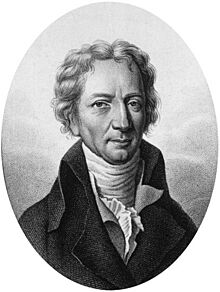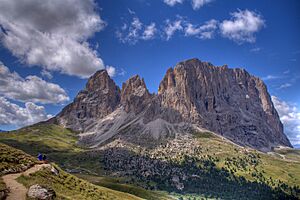Déodat Gratet de Dolomieu facts for kids
Quick facts for kids
Déodat Gratet de Dolomieu
|
|
|---|---|

Déodat Gratet de Dolomieu (drawing by M. Cordier, engraved by Ambroise Tardieu)
|
|
| Born | 23 June 1750 |
| Died | 28 November 1801 (aged 51) |
| Nationality | French |
| Known for | First description of the rock named dolomie (or dolomite) |
| Awards | |
| Scientific career | |
| Fields | Geology Mineralogy Volcanology |
Déodat de Dolomieu (born June 23, 1750 – died November 28, 1801) was a famous French geologist. He is best known for discovering a special type of rock and mineral. Both the rock and the mineral are now called dolomite after him. Also, a large crater on the Piton de la Fournaise volcano is named in his honor.
Contents
Discovering Déodat de Dolomieu
Déodat de Dolomieu was born in Dauphiné, France. He was one of 11 children in his family. Even as a child, Déodat was very smart. He loved learning about nature, especially the Alps mountains near his home.
At just 12 years old, Déodat started a military career. He joined the Knights of Saint John, also known as the Knights of Malta. This group caused him some trouble later in life. For example, when he was 18, he was briefly imprisoned. This happened after a serious disagreement with another member of the Knights. Luckily, he was released after only a year.
Dolomieu's Scientific Journey
Before the French Revolution began in 1789, Dolomieu was very active in the world of science. He made many friends among important people. Through his friend, the Duke de La Rochefoucauld, Dolomieu became a member of the Royal Academy of Sciences.
He spent his free time traveling across Europe. He collected different mineral samples and visited mining areas. Dolomieu was especially interested in mineralogy (the study of minerals) and volcanology (the study of volcanoes). He also studied how mountain ranges were formed.
Even though he loved volcanoes, Dolomieu believed that water played a huge role in shaping Earth. He thought that big, sudden events in the past changed the Earth's surface. This idea was different from some other scientists of his time.
One of his biggest contributions was discovering the mineral and rock that would be named after him: dolomite.
The Story of Dolomite Rock

During one of his trips to the Alps in Tyrol (which is now part of Italy), Dolomieu found a unique rock. This rock looked like limestone but acted differently. When he put weak hydrochloric acid on it, it did not fizz. Limestone usually fizzes a lot with acid.
He wrote about his discovery in 1791 in a famous French science magazine. In March 1792, another scientist, Nicolas-Théodore de Saussure, named the rock dolomie. Today, we call it dolomite. Not only the rock and its main mineral are named after him, but also the beautiful Dolomites mountain range in Italy.
It's interesting to know that Dolomieu wasn't the very first person to notice this rock. Another scientist, Carl Linnaeus, had also observed that this rock was like limestone but didn't fizz with acid. However, Dolomieu's detailed description helped make the discovery widely known.
Life with the Knights of Malta
While doing his science work, Dolomieu also rose in rank within the Knights of Malta. He became a commander in 1780. However, his modern political ideas were not popular with the older, more traditional leaders of the Order. Because of these disagreements, Dolomieu decided to leave active military service in 1780. This allowed him to focus all his time on his travels and scientific studies.
Changes During the French Revolution
At first, Déodat de Dolomieu strongly supported the French Revolution when it started in 1789. But as the revolution became more violent, he changed his mind. His friend, the Duke de la Rochefoucauld, was killed. Dolomieu himself barely escaped being executed. Many of his relatives were also harmed. These events turned him against the revolution.
During this difficult time, Dolomieu became a supporter of Napoleon Bonaparte. In 1795, after losing his money in the revolution, Dolomieu became a professor. He taught natural sciences at the École Centrale Paris. He also started writing about minerals for a large encyclopedia. The next year, he became an inspector of mines and a professor at the École Nationale Supérieure des Mines de Paris. His portrait still hangs in the library there. His huge collection of minerals is now kept at the Muséum National d'Histoire Naturelle in Paris.
Adventures with Napoleon
By 1798, Déodat de Dolomieu was known worldwide as a leading geologist. He was invited to join a scientific team with Napoleon Bonaparte. This team went with Napoleon's army during the invasion of Egypt. Dolomieu was part of the natural history and physics section.
In March 1799, Dolomieu became sick and had to leave Egypt to return to France. His ship got caught in a storm and had to stop in Taranto, Italy. There, Dolomieu was taken prisoner of war. The city was fighting against France at the time.
Dolomieu had made an enemy of the leader of the Maltese order earlier. He had helped negotiate when the island of Malta surrendered to Napoleon. Because of this, the Maltese leader spoke out against Dolomieu. He was then moved to Messina, Sicily, and held in terrible conditions. He was kept alone in prison for 21 months.
The imprisonment of such a famous scientist shocked people across Europe. Even scientists in England, who were at war with France, protested his capture. Napoleon Bonaparte, who was then the leader of France, decided to act directly. In the spring of 1800, Napoleon led the French army into Italy. They won a major battle, and all of Italy came under Napoleon's influence.
One of the terms Napoleon demanded in the peace treaty (signed in March 1801) was Dolomieu's immediate release.
After he was freed, Dolomieu went back to his scientific studies and field trips. But his health had been badly damaged by his long time in prison. He became very ill during a trip to the Alps. Déodat de Dolomieu passed away on November 28, 1801, at his sister's home in Châteauneuf.
His Important Works
Lasting Legacy
Dolomieu's student, the famous naturalist Jean-Baptiste Bory de Saint-Vincent, honored him in 1801. He named the largest crater on the Piton de la Fournaise volcano, on the French island of Réunion, the cratère Dolomieu. This shows how important Dolomieu's work was to the study of geology and volcanoes.
Images for kids



